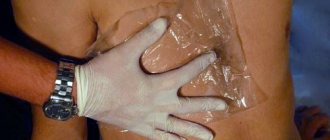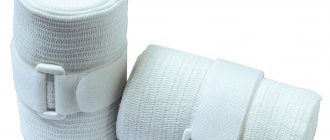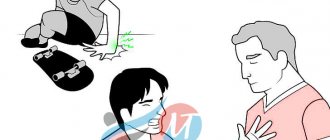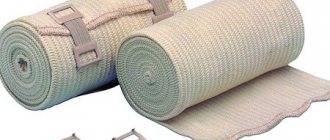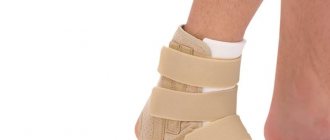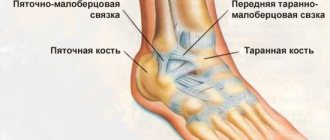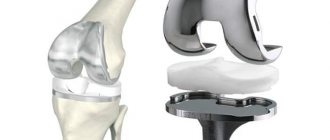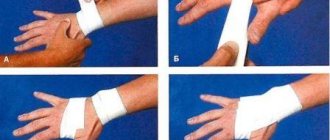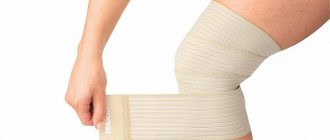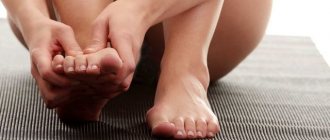- Ankle bandage
When using, you need to know how to properly bandage your leg with an elastic bandage:
- You need to tie an elastic bandage on your leg while lying down immediately after waking up;
- You need to bandage your leg from the ankle up, grabbing the heel;
- each subsequent turn of the bandage should overlap the previous one by 30–50%; for better fixation, the heel should be bandaged in a figure eight;
- The bandage should be applied evenly, gradually loosening it. The bandage should not be overtightened so as not to disrupt blood microcirculation;
- The bandage should be removed during sleep, unless there are additional instructions in this regard.
Types of elastic bandages
Products differ in two main parameters: purpose and degree of elongation.
By purpose there are:
- compression - widely used in phlebology for the treatment and prevention of vein diseases;
- fixing bandages that prevent or compensate for the consequences of sprains and dislocations;
- fixing postoperative dressings.
According to the degree of extensibility, bandages are:
- short stretchable with an elasticity coefficient of no more than 70%;
- medium-tensile - the elongation coefficient is 70–140%;
- Highly stretchable, so-called motion bands, provide the most gentle compression. The stretch ratio is more than 140%.
Based on their shape, bandages are divided into tubular and tape.
Bandage sizes
Elastic tape bandages have a width from 6 to 20 cm and a length from 4 to 7 m.
Recommendations for choosing a suitable bandage should be obtained from your doctor and strictly followed.
The main advantages of an elastic ankle bandage
- Elastic bandages can be used repeatedly and, if they are made in compliance with the rules and regulations, they will not deform even after washing. This practicality will save you a certain amount of money.
- This product does not deform and does not slip after applying a bandage. Even the bends of the joints are not an obstacle to reliable fixation.
- Since the bandage is universal, it can be used for damage to almost ANY part of the body.
- No special skills or abilities are required to apply a fixing bandage to the ankle joint.
- This product is quite easy to use and can replace up to 20 simple gauze dressings.
However, there are a number of disadvantages to this type of fixation. Most of them are caused by improper use of the elastic bandage:
- impaired blood flow due to excessive compression;
- impaired bandaging technique;
- Poor care of the bandage contributes to loss of elasticity.
Also, this type of bandage can be used to fix a splint for cracks or fractures of tubular or spongy bones.
Indications and contraindications
You need to know what an elastic bandage is for:
- in case of varicose veins of the lower extremities;
- to bandage the foot with an elastic bandage in case of sprained ligaments and tendons;
- to maintain the correct position and maintain the integrity of the joints;
- for the purpose of treating degenerative-dystrophic diseases of the joints;
- for rehabilitation in the postoperative period;
- as a prophylaxis against thrombosis.
Contraindications to the use of compression elastic bandages include:
- late stage heart failure;
- infectious diseases of the extremities in the acute stage;
- diabetic foot syndrome;
- vascular diseases accompanied by obliteration - fusion or closure of blood vessels with connective tissue as a result of an inflammatory process or tumor growth.
How to apply a bandage to a leg in case of injury
There are general rules for bandaging the lower extremities.
Before the manipulation, the victim should be given the most comfortable and functional position to minimize pain in the future.
Ensure limb immobility by extending it at the hip and knee joints 180 degrees or bending the ankle 90 degrees (if possible).
Using existing furniture (table or chair), place the injured part of the leg as high as possible, preferably at the chest level of the person providing assistance.
While applying the bandage, constantly monitor the condition of the victim: if there is a clear deterioration, the tension of the bandage should be loosened and the direction of the turns should be changed.
Arrests of doctors: rheumatologists deprived patients of the most effective remedy for joint pain!
Bubnovsky Sergey Mikhailovich
leading rheumatologist of the country, deputy. Chairman, 1st Deputy Director of the Federal State Budgetary Institution NIIR named after. V. A. Nasonova
Find out more...
What is happening is what our law enforcement agencies should have done a long time ago - arrest this entire mafia. Just think about these numbers - more than 1 million crippled lives in 12 years! People, most of them pensioners, turned to doctors for help. And instead of treating, they profited from people’s suffering, knowing in advance that the remedies they prescribed would not help. And this practice was widespread not only in commercial ones, but also, worst of all, in public clinics.
The width of the bandage used depends on the location of the lesion and can range from 10 to 14 cm.
The free end of the bandage should be held in the left hand, the bandage itself in the right.
First, make a couple or three fixing turns.
The bandage should be applied from left to right so that the next layer covers the previous one approximately halfway. For ease of movement, the bandage is folded at the folds.
At the end of bandaging, the ends are secured.
Pros and cons of using
Like any therapeutic agent, elastic bandages have advantages and disadvantages.
Advantages:
- Ease of use;
- reusable;
- versatility - can be applied to any part of the body;
- reliable fixation.
Flaws:
- a feeling of itching and peeling of the skin under the bandage;
- the need for qualified assistance in applying a bandage to elderly patients or patients with limited mobility;
- feeling of discomfort in the warm season;
- difficulties in choosing clothes and shoes.
Basic rules for bandaging
The issue under consideration in surgery is given a separate section - desmurgy. The teaching identifies several purposes for attaching medical goods (bandages, scarves) to the patient’s legs. All soft bandages used for bandaging the lower extremities are classified into 4 types:
- Protective (ordinary).
- Pressure, used primarily to stop bleeding.
- Immobilizing, fixing the injured area.
- Corrective, corrective deformities of joints.
Incorrect technique for applying a bandage to the lower limb leads to the development of complications - swelling, tissue necrosis. To avoid negative consequences, you should adhere to the basic rules of bandaging.
Before providing assistance, it is necessary to give the victim a comfortable, functionally beneficial position that minimizes pain as much as possible. The limb should be motionless, if possible extended to 180º at the knee and hip joints, and bent at a right angle at the ankle.
The part of the leg to be bandaged must be placed at the level of the operator's chest. The goal can be achieved by using a table or chair.
When carrying out manipulations, the dresser is obliged to monitor the patient’s condition. If the process is accompanied by a deterioration in the patient’s well-being, then the tension of the medical device used should be immediately loosened, and the direction of the turns (turns) should be changed.
The choice of bandage size is carried out taking into account the location of the lesion.
Both hands are involved in manipulations; the head of the rolled gauze should be held in the right, a free piece of linen in the left.
The list of basic rules for carrying out procedures contains 3 points:
- Fixing the beginning of the material used using circular tours.
- Rotating a strip of medical tissue around the injured area from left to right. Each subsequent turn should cover from 50% to 2/3 of the total width of the previous one. In conical areas, the bandage should be folded.
- Fastening (with a knot, a pin) the ends of the product.
Bandaging must be carried out according to plan, using 1 of the following types of bandages.
In China, they don’t know what back or joint pain is, and they don’t see a doctor until they’re 80 years old!
Konstantin Kovalev
Read more…
Good afternoon My name is Konstantin Kovalev, I have been treating diseases of the musculoskeletal system in Russia for more than 30 years. Imagine my surprise when I learned about the unique development of our scientists... at a conference in Shanghai!
Overlay technique
Depending on where the bandage is applied, a strict sequence of actions must be followed.
Ankle bandage
How to bandage your leg with an elastic bandage in the ankle area:
- The ankle should be wrapped with an elastic bandage, starting with two turns around the ankle.
- Then make two turns, starting from the back of the foot;
- Next, wrap the bandage around the ankle again.
- Repeat the required number of times until the entire ankle is secured with an elastic bandage.
- The bandage is secured under the ankle.
Wrist band
When bandaging your wrist:
- The bandage is fixed in one turn around the wrist.
- Stretch it from the back of the hand between the thumb and index finger, then return through the palm to the wrist.
- After this, the bandage is pulled through the palm and returned to the wrist.
- Repeat the required number of rounds of the bandage until the joint is completely fixed.
- Attach a bandage to your wrist.
Knee (or elbow) bandage
When applying the bandage, the knee or elbow should be in a comfortable flexed position.
- Wrap the bandage two turns below the joint.
- From the back of the arm or leg, the bandage is pulled above the joint and made two turns.
- Perform overlapping turns above and below the joint until it is completely closed.
- Secure the end of the bandage in a convenient place below or above the joint.
General recommendations
- You need to wind the elastic bandage, overlapping each next turn with the previous one by no less than a third of the width and no more than half.
- The tension of the bandage should be loosened as you move from the narrow part to the wide part.
- The bandage should not have gaps or folds.
- It is convenient to use self-fixing bandages.
How can you tell if the bandage is applied incorrectly?
There are several signs that the bandaging was incorrect and should be redone. These are the following signs:
- Blueness of the toes that does not go away even after moving the toes. Indicates that the bandage is very tight and venous blood flow is impaired.
- The toes and the foot itself are cold and pale. A symptom of deterioration in arterial blood circulation.
- The leg goes numb and throbs under the bandage. If such sensations do not go away within half an hour, then the bandage is too tight.
- The leg walks and the bandage falls off. This indicates insufficient immobilization of the ankle. The bandage was not tightened properly or the bandaging technique itself was incorrect.
The presence of at least one of the symptoms requires urgent removal of the bandage.
After this, it is recommended to take a lying position, put your leg on a pillow and massage it a little, this will help normalize blood circulation. After this, the ankle can be re-bandaged according to the instructions and do not forget about the force of compression of the joint with the bandage.
How long to wear
The wearing time of the bandage may vary depending on the purpose of its application. It is necessary to clearly understand how long you can wear an elastic bandage in each specific case, so as not to aggravate the situation.
- It is recommended to wear the bandage on the ankle, elbow, knee, wrist, and shoulder for 5–6 hours a day, always removing it at night.
- A postoperative dressing is applied an hour before surgery, then left for a day, including overnight. The exact time of wearing such a bandage is determined by the doctor.
- For varicose veins, the bandage is worn no more than 6–7 hours a day.
- The duration of wearing the bandage during surgery on large vessels is determined by the doctor. It can take up to 2–3 weeks.
Permissible duration of wearing a bandage
The question of how long elastic bandages should be worn should be decided by the attending physician (traumatologist or orthopedist). The period of time directly depends on how severe the damage is and on the characteristics of the recovery period.
For a first-degree sprain (accompanied by mild swelling and tolerable pain on exertion), the bandage is worn for 7 days. For grades 2 and 3 (pain is severe and swelling is more extensive) you will have to use bandages for about 2 or 3 months. Usually, along with applying bandages, patients are simultaneously prescribed the use of medicinal gels or ointments.
As for daily wearing of the bandage, it should be removed whenever there is an opportunity to rest and give your feet rest. You cannot wear the bandage for more than 12 hours without a break. Ideally, continuous use of the dressing should be reduced to two hours. It is also prohibited to sleep in an elastic restraint.
#2: Preventing Dislocations: What Can You Do?
Dislocation is the displacement of bones in a joint relative to each other. The injury does not pose a serious health risk, but it can also cause future damage to your joints. Due to the incorrect location of the bones, the cartilage surfaces are subject to additional stress and wear out faster. Cracks form on them, and pain occurs upon contact.
To minimize the risk of dislocations, follow these tips:
- do not engage in traumatic sports, such as football, which most often provokes dislocations in players;
- warm up every day and strengthen your muscles and ligaments;
- choose shoes with hard soles and avoid slippers that do not provide stability;
- train the stability and coordination needed to prevent sprains by jumping rope;
- If you have an injury, do not reset the dislocation yourself.
Any injury is a reason to seek help from an orthopedist or traumatologist
Bandage for the entire lower limb
Extensive damage requires the use of a combination of the techniques discussed in the material above and the use of gauze rolls of different widths. The optimal choice of the operator is to perform the returning and spiral with kinks methods of applying the web.
Quick and correct closure of the wound with medical tissue is a factor that helps speed up the recovery process of the injured person. The importance of having basic knowledge on desmurgy cannot be overestimated: it helps to provide qualified, timely assistance and save the life of the victim.
